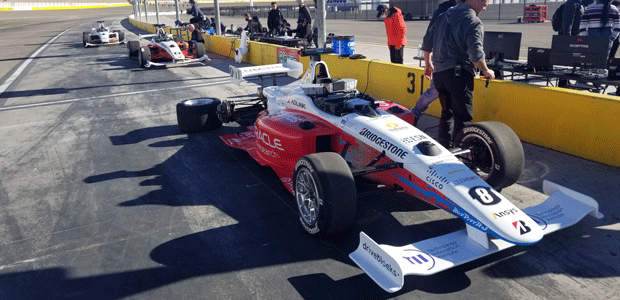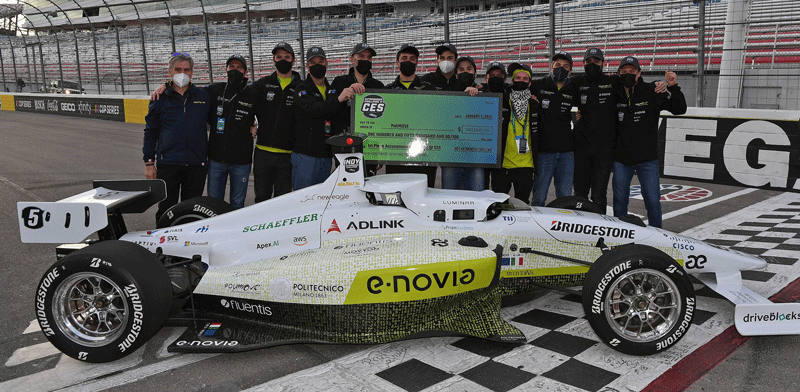
Racing Technology To Drive the Future of Autonomous Vehicles
Automotive technology at CES has grown so much over the years that for 2022, the show devoted the entirety of its new Las Vegas Convention Centre West Hall to what is now widely recognised – if it were a stand-alone event – as one of the largest auto shows in the world. At the recently concluded celebration of technological innovation, show attendees witnessed the launch – or the visionary introductions – of such features as the color-changing BMW iX Flow, Cadillac’s InnerSpace automotive theatre (for when self-driving cars become a reality), LG’s Omnipod 'office in a car' and more.
But while these any other vehicular marvels drew the attention and wonder of those in attendance, the most exciting automotive-based activity took place 25km north of the Strip at the Las Vegas Motor Speedway.
Officially staged on Friday, January 7, the Indy Autonomous Challenge (IAC) was a spirited Indy-style race competition contested by university students who programmed full-sized autonomous-modified open wheel racecars. The teams arrived in Vegas last weekend, and following a full-week of practice at the city’s storied racetrack, went-head to head to determine an eventual champion, who pocketed the competition’s £110,000 top prize.
While PoliMOVE – a hybrid team of students from Italy’s Politecnico di Milano and the University of Alabama – took top competition honors, the real winner is the future of autonomous driving.
“The focus of this competition is to develop – alongside all the other teams – the algorithms and research designed to push the limits for autonomous driving,” said Phillip Karle, team leader from TUM Autonomous Motorsport, a collection of 15 PhD students from the Institute of Automotive Technology in Munich, Germany. The program, Karle said, “is supported by the university, but also by partners from within the industry as well as graduate students, undergraduate students and our team members, all of whom worked together to develop the software necessary to drive the vehicles.”

While individuals attending Friday’s event might have expected to see nine cars on the racetrack competing simultaneously, what they actually witnessed were two cars racing head-to-head, attempting to pass and maneuver while finishing first around the track to advance to the next round.
But if you were expecting a team of students operating their vehicles through a radio controlled interface, think again. The moment these vehicles hit the track, they are entirely on their own – fully autonomous – which means the racecars make their own AI-based decisions when to speed up, when to slow down, when to maneuver and when to pass.
“This is truly a passing competition where we have two cars on the track at the same time, passing one another at increasingly higher and higher speeds,” said Paul Mitchell, president and CEO of Energy Systems Network, the company that produced the IAC. “Eventually, one car will be able to pass and when that happens, and the winner will advance the next round.”
This is important, Mitchell said, because there have never before been high speed autonomous vehicles running different algorithms, engaging one another and having to make decisions the way human drivers do.
“It's absolutely critical that we advance high-speed automation, because if we’re ever going to have truly autonomous vehicles encountering one another on the highway at 70, 80 miles an hour, we need to know that this can be done safely.
“To address this concern, we created this prize competition that would attract the best and brightest minds to work on high-speed automation; and what better way to do so than at the platform of motorsports and racecars that can run at a major speedway?”
According to Mitchell, the Las Vegas Indy Autonomous Challenge was the culmination of a three-year journey built upon the impact created by the DARPA Grand Challenge in 2004 and 2005, which essentially launched what has become the modern autonomous vehicle industry.
“We saw that while industry was advancing the state-of-the-art in low-speed automation on urban and suburban settings, there really wasn’t enough work being done at high-speed automation,” Mitchell said. “And that’s what the IAC is all about.”
The program is also all about building the industry, and as part of the week’s activities, Karle’s TUM Autonomous Motorsport – the competition runner-up to PoliMOVE – announced the launch of a new Autonomy Platform company called Driveblocks with a vision to offer a modular, scalable, robust and safe platform for fully autonomous vehicles. The company plans to focus entirely on applications without any human drivers, with an early roadmap targeting the commercial vehicle sector to first offer a complete solution to fleet automation and then allow customers to focus on domain-specific expertise (mining, agriculture, warehouse logistics, etc.)
The IAC competition consisted of nine teams from 19 universities spanning eight nations, six of which were combined teams that worked across international borders to design the most powerful, creative and impactful software possible to control their vehicles. And this past week, they all gathered in person to vie for top honors. In addition to the U.S., Germany and Italy, nations represented included India, Colombia, South Korea, Canada and the UAE.
“The whole idea here is to push the frontiers of robotics and artificial intelligence and autonomous vehicles in general, and we do so by demonstrating how stable our cars are, that they can really go safely at 150mph.” said University of Virginia (UVA) Computer Science Professor Madhur Behl, who also serves as principal for the Cavalier Autonomous Racing Team.
“UVA has been part of this competition since the very beginning in 2019. In October of last year, we ran the first part of this competition, a historic race held at the Indianapolis Motor Speedway.
“We did very well there – we were the fastest of ten American teams with an average speed of 125mph. After that big success, the students continued to work hard developing the software, designed so that our vehicle will overtake other cars. We call this spec racing.”

As Behl explained, each of the nine race teams received an identical vehicle – an IAC Dallara AV-21 – the most technologically advanced, fastest autonomous racecar ever assembled, each of which has been retrofitted with systems and controls to enable automation.
“There is no hardware advantage,” Behl said. “Each car has the same engine, the same tires, the same sensors. The only way you can beat another team is by having better software.”
But to echo Karle’s comments, Behl says it’s not really all about winning. “Ultimately we are trying to demonstrate that at high speeds, if your car is stable and can effectively navigate around another car at more than 100mph, then there’s a chance that some of this technology will eventually get transferred to regular self-driving cars and improve their overall safety as well.”
Ultimately, when that happens, then everybody comes out a winner.

